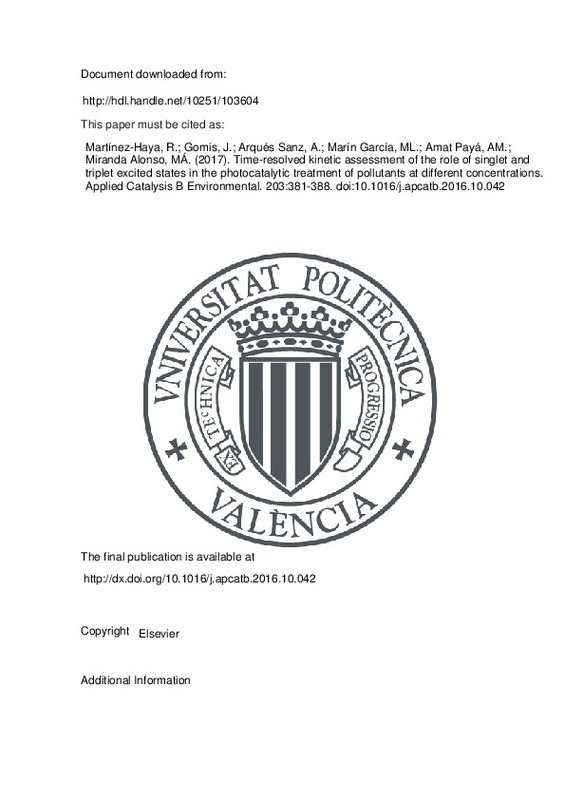JavaScript is disabled for your browser. Some features of this site may not work without it.
Buscar en RiuNet
Listar
Mi cuenta
Estadísticas
Ayuda RiuNet
Admin. UPV
Time-resolved kinetic assessment of the role of singlet and triplet excited states in the photocatalytic treatment of pollutants at different concentrations
Mostrar el registro sencillo del ítem
Ficheros en el ítem
| dc.contributor.author | Martínez-Haya, Rebeca
|
es_ES |
| dc.contributor.author | Gomis, J.
|
es_ES |
| dc.contributor.author | Arques Sanz, Antonio
|
es_ES |
| dc.contributor.author | Marín García, Mª Luisa
|
es_ES |
| dc.contributor.author | Amat Payá, Ana María
|
es_ES |
| dc.contributor.author | Miranda Alonso, Miguel Ángel
|
es_ES |
| dc.date.accessioned | 2018-06-08T04:21:10Z | |
| dc.date.available | 2018-06-08T04:21:10Z | |
| dc.date.issued | 2017 | es_ES |
| dc.identifier.issn | 0926-3373 | es_ES |
| dc.identifier.uri | http://hdl.handle.net/10251/103604 | |
| dc.description.abstract | [EN] A kinetic-based rationale to assess the role of each excited species in thermodynamically favoured photocatalytic processes at different pollutant concentrations, has been developed and illustrated with new experimental data. Specifically, 2,4,6-triphenylthiapyrylium (TPTP+) salt has been chosen as a representative organic compound capable to act as photocatalyst, and the possible involvement of its excited states in the photodegradation of pollutants commonly found in aqueous ecosystems has been investigated using five chemicals, namely acetaminophen, acetamiprid, caffeine, clofibric acid and carbamazepine. First, steady-state photolysis has been carried out under simulated solar irradiation in the presence of TPTP+, and second, photophysical measurements (fluorescence and laser flash photolysis) have been performed in order to obtain reliable fast kinetic data. Thermodynamic considerations allow ruling out energy transfer processes, while the kinetic results are in good agreement with an electron transfer to the triplet excited state of TPTP+. Hence, the higher the intersystem crossing quantum yield the better. Although quenching of the singlet excited state is also observed, the contribution of this reactive species is only minor, due to its shorter lifetime. In general, the efficiency of a photocatalyst should be enhanced at higher pollutant concentrations, at which the intrinsic decay of the triplet excited state is minimized. (C) 2016 Elsevier B.V. All rights reserved. | es_ES |
| dc.description.sponsorship | Financial support from Spanish Government (Grants SEV-2012-0267, CTQ2012-38754-C03-03 and CTQ2015-69832-C4-4-R) and Generalitat Valenciana (Prometeo Program) is gratefully acknowledged. R. Martinez-Haya thanks financial support from Spanish Government (Grant SEV-2012-0267). We also thank support from VLC/Campus. | es_ES |
| dc.language | Inglés | es_ES |
| dc.publisher | Elsevier | es_ES |
| dc.relation.ispartof | Applied Catalysis B Environmental | es_ES |
| dc.rights | Reserva de todos los derechos | es_ES |
| dc.subject | Electron transfer | es_ES |
| dc.subject | Laser flash photolysis | es_ES |
| dc.subject | Photo-redox catalysis | es_ES |
| dc.subject | Singlet excited state | es_ES |
| dc.subject | Triplet excited state | es_ES |
| dc.subject.classification | INGENIERIA TEXTIL Y PAPELERA | es_ES |
| dc.subject.classification | QUIMICA INORGANICA | es_ES |
| dc.subject.classification | QUIMICA FISICA | es_ES |
| dc.subject.classification | QUIMICA ANALITICA | es_ES |
| dc.subject.classification | QUIMICA ORGANICA | es_ES |
| dc.title | Time-resolved kinetic assessment of the role of singlet and triplet excited states in the photocatalytic treatment of pollutants at different concentrations | es_ES |
| dc.type | Artículo | es_ES |
| dc.identifier.doi | 10.1016/j.apcatb.2016.10.042 | es_ES |
| dc.relation.projectID | info:eu-repo/grantAgreement/MINECO//CTQ2012-38754-C03-03/ES/DESARROLLO DE NUEVAS ESTRATEGIAS BASADAS EN LA INTEGRACION DE PROCESOS FOTOQUIMICOS SOLARES CON OTRAS TECNICAS AVANZADAS PARA EL TRATAMIENTO DE AGUAS RESIDUALES COMPLEJAS/ | es_ES |
| dc.relation.projectID | info:eu-repo/grantAgreement/MINECO//CTQ2015-69832-C4-4-R/ES/TECNOLOGIAS EFICIENTES PARA LA ELIMINACION DE CONTAMINANTES DE PREOCUPACION EMERGENTE, CONTENIDOS EN DIRECTIVA 2013%2F39%2FCE O DE RIESGO SIGNIFICATIVO SEGUN DIRECTIVA 2008%2F105%2FCE/ | es_ES |
| dc.relation.projectID | info:eu-repo/grantAgreement/MINECO//SEV-2012-0267/ | es_ES |
| dc.rights.accessRights | Abierto | es_ES |
| dc.date.embargoEndDate | 2019-04-30 | es_ES |
| dc.contributor.affiliation | Universitat Politècnica de València. Departamento de Ingeniería Textil y Papelera - Departament d'Enginyeria Tèxtil i Paperera | es_ES |
| dc.contributor.affiliation | Universitat Politècnica de València. Instituto Universitario Mixto de Tecnología Química - Institut Universitari Mixt de Tecnologia Química | es_ES |
| dc.contributor.affiliation | Universitat Politècnica de València. Departamento de Química - Departament de Química | es_ES |
| dc.description.bibliographicCitation | Martínez-Haya, R.; Gomis, J.; Arques Sanz, A.; Marín García, ML.; Amat Payá, AM.; Miranda Alonso, MÁ. (2017). Time-resolved kinetic assessment of the role of singlet and triplet excited states in the photocatalytic treatment of pollutants at different concentrations. Applied Catalysis B Environmental. 203:381-388. https://doi.org/10.1016/j.apcatb.2016.10.042 | es_ES |
| dc.description.accrualMethod | S | es_ES |
| dc.relation.publisherversion | http://dx.doi.org/10.1016/j.apcatb.2016.10.042 | es_ES |
| dc.description.upvformatpinicio | 381 | es_ES |
| dc.description.upvformatpfin | 388 | es_ES |
| dc.type.version | info:eu-repo/semantics/publishedVersion | es_ES |
| dc.description.volume | 203 | es_ES |
| dc.relation.pasarela | S\326917 | es_ES |
| dc.contributor.funder | Ministerio de Economía y Competitividad | es_ES |
| dc.contributor.funder | Ministerio de Economía, Industria y Competitividad | es_ES |







![[Cerrado]](/themes/UPV/images/candado.png)

